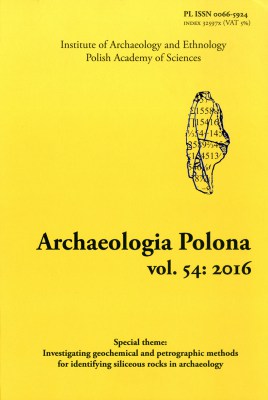
Archaeologia Polona vol.54: 2016
Informacje bibliograficzne
Czasopismo: Archaeologia Polona vol.54: 2016
Redaktor: Aleksandra Rzeszotarska-Nowakiewicz
Tytuł: Special Theme: Investigating geochemical and petrographic methods for identifying siliceous rocks in archaeology
Redaktor tomu: Dagmara H. Werra, Richard E. Hughes
Wydawca: Institute of Archaeology and Ethnology Polish Academy of Sciences
Miejsce: Warsaw
Rok wydania: 2016
Język: angielski
Liczba stron: 200
Format: B5
Okładka: miękka
ISSN: 0066-5924
Opis
The first scientific investigations of the sources of flint in Poland were undertaken by archaeologist Stefan Krukowski and geologist Jan Samsonowicz in the early 20th century. Krukowski used archaeological materials to identify the macroscopic characteristics of 'chocolate' flints, described their differences, and showed the potential location of the deposits (Krukowski 1920: 189-195; Budziszewski 2008: 33). In the search for deposits of Hint, their outcrops, and prehistoric mines, Krukowski was accompanied by young geologist Jan Samsonowicz. Ihe result of their cooperation was the discovery in 1921 of in situ deposits and surface accumulations of limestones containing fragments of Hint and, in 1922, the identification of a prehistoric mine at Krzemionki Opatowskie (Krukowski 1923; Samsonowicz 1923; Bąbel 2014).
Spis treści
Dagmara H. Werra, Richard E. Hughes, Editorial
Zofia Sulgostowska and Andrzej J. Tomaszewski, On the 80th birthday of Professor Romuald Schild
Katarzyna Kerneder-Gubała, Bibliography of Romuald Schild - from 2005-2016
Andrzej Pelisiak, Siliccous raw material from Bieszczady Mountains: Sources and use
Zsolt Mester and Norbert Faragó, Prehistoric exploitation of limnosilicites in Northern Hungary: problems and perspectives
Jacek Kabaciński and Iwona Sobkowiak-Tabaka, A Newly Discovered Source of'Banded Flint' in the Polish Lowlands
Iwona Sobkowiak-Tabaka, Dagmara H. Werra, Richard E. Hughes and Rafał Siuda, Erratic Flint from Poland: Preliminary results of pétrographie and gcochemical analyses
Marcin Szeliga and Miłosz Huber, Mineralogical and pétrographie characteristic of basic types of Turanian flints from the north-eastern margin of the Holy Cross Mountains: a preliminary report
Richard E. Hughes. Dagmara H. Werra and Rafał Siuda, On The Chemical Composition of 'Chocolate' Flint from Central Poland
Ryan M. Parish, Reflectance spectroscopy as a chert sourcing method
Henrik Zoltdn Tóth, Palaeolithic heat treating in Northeastern Hungary?: An archaeometric examination of the possible use of fire-setting in Stone Age quarries in the Biikk area
Jolanta Małecka-Kukawka, Grażyna Szczepańska, Marta Rauchfleisz and Łukasz Kowalski, Archaeometric study of some functional tools from the Sąspów and Wierzbica 'Zele' flint mines sites
Stanisław Wilk and Bernadeta Kufel-Diakowska, "The Lublin-Volhynian culture retouched blade daggers in light of usewear analysis of artefacts from burials at site 2 in Książnice, Poland
Åsa Eriksson Berggren, Anders Hőgberg, Deborah Olausson and Elisabeth Rudebeck, Early Neolithic flint mining at Södra Sallerup. Scania, Sweden
Mirosław Furmanek and Mirosław Masojć, The use of erratic stone by the communities of the Linear Pottery culture: a view from the excavations in Kostomłoty, site 27. province of Lower Silesia

